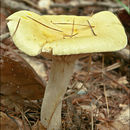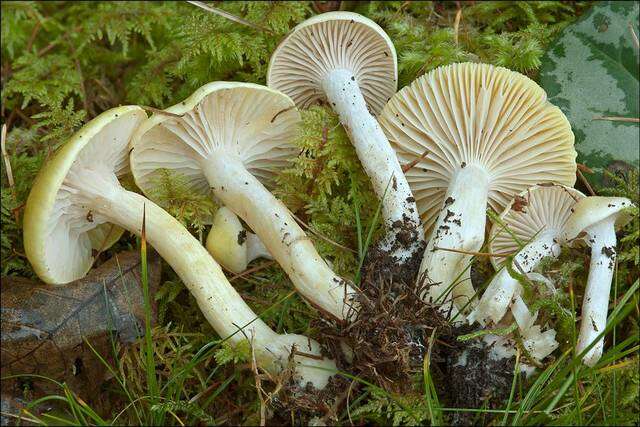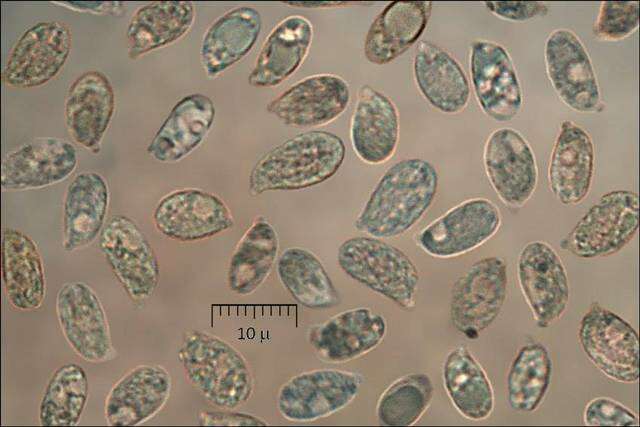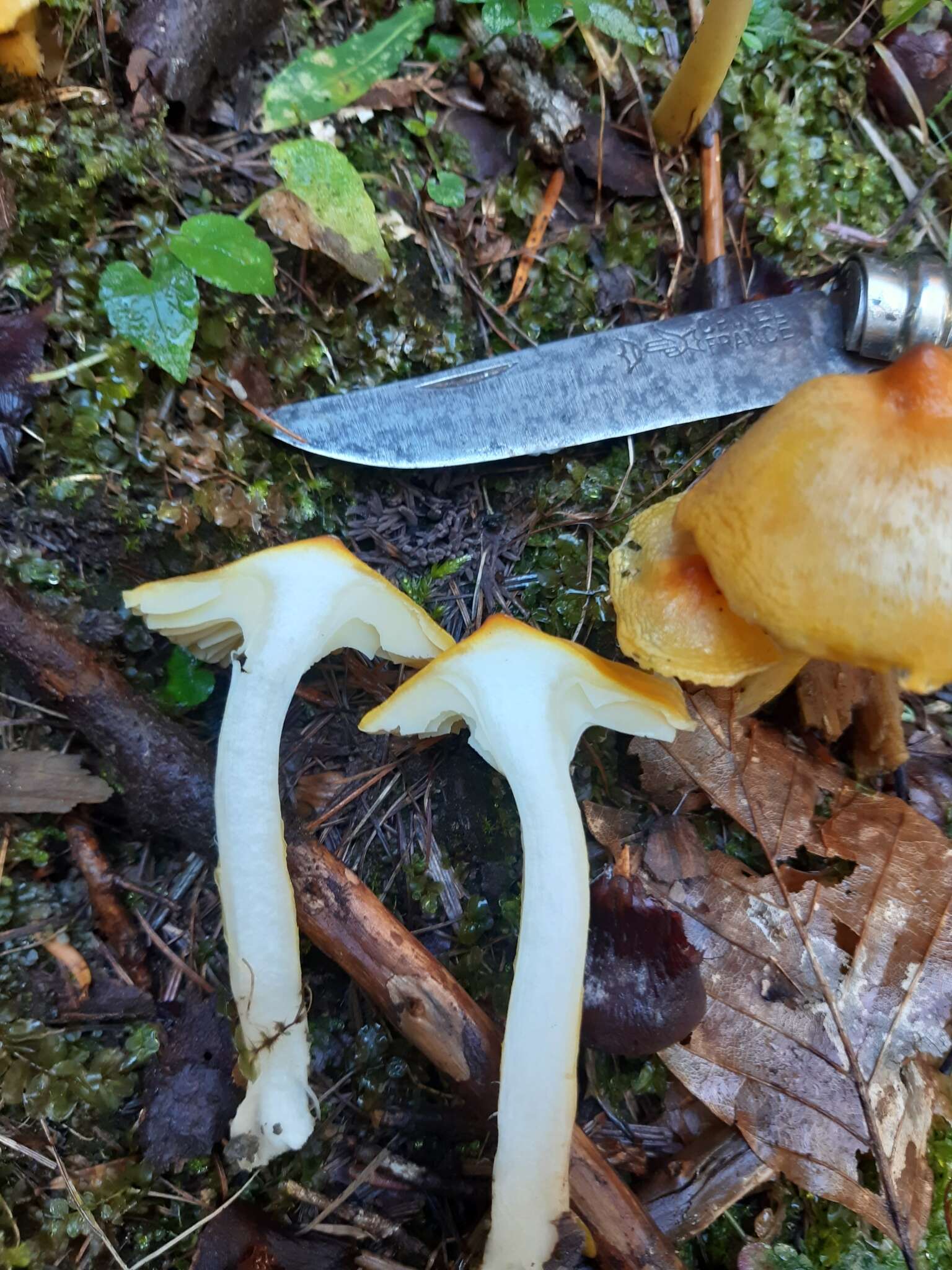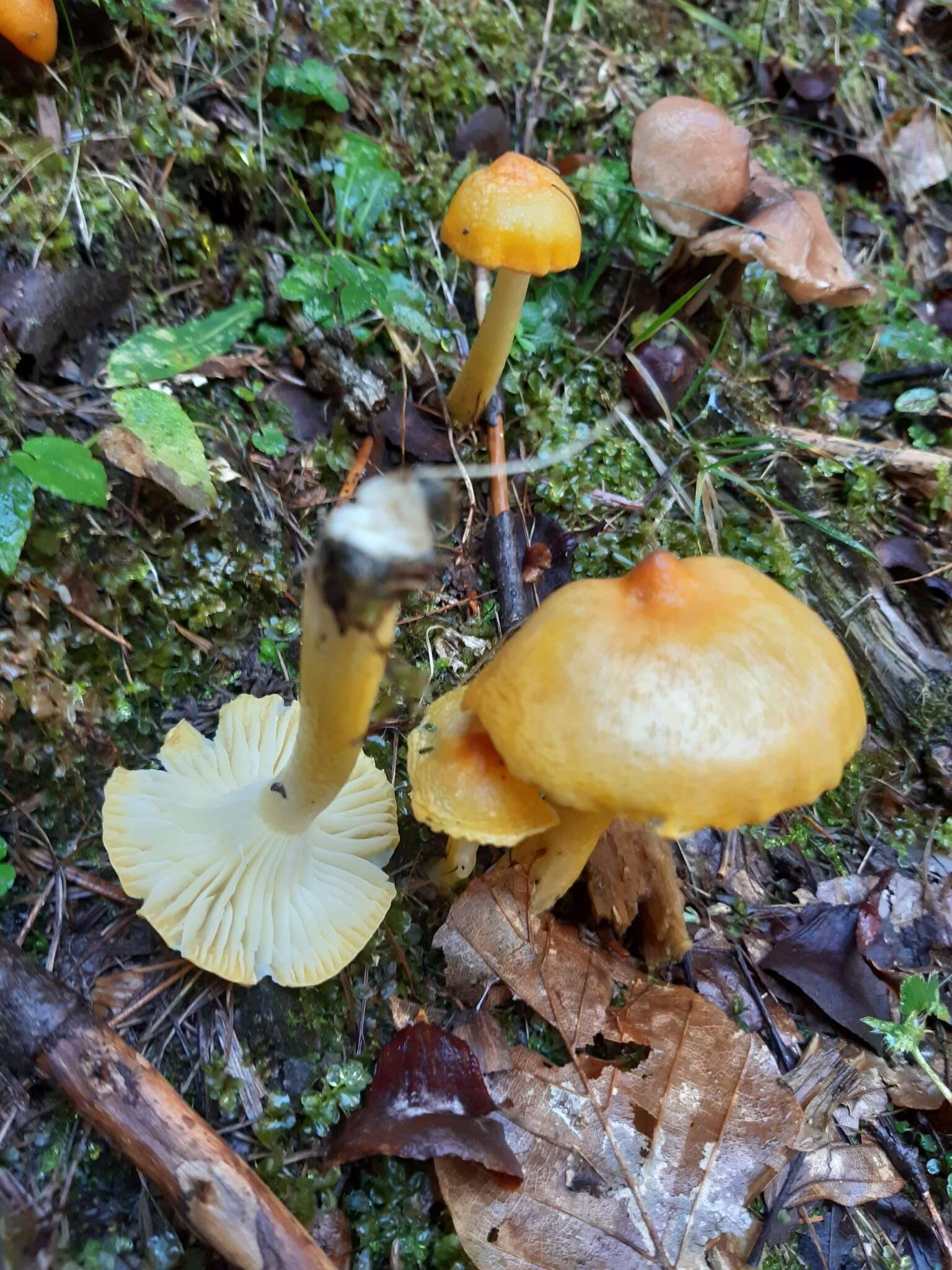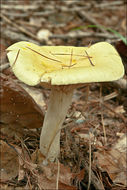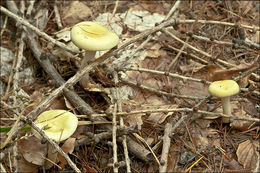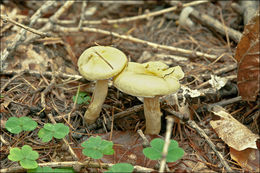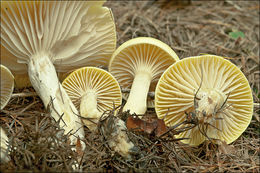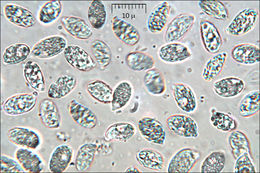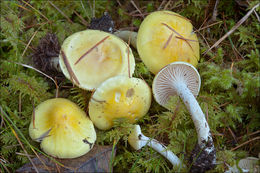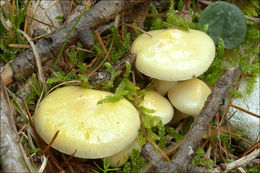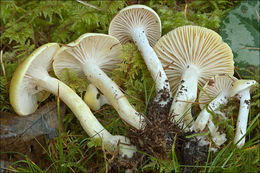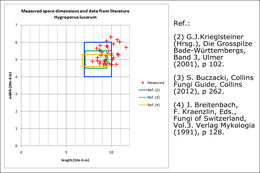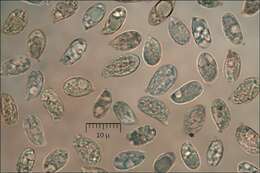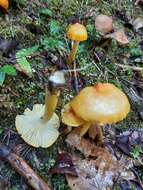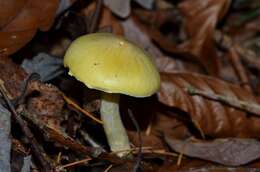-
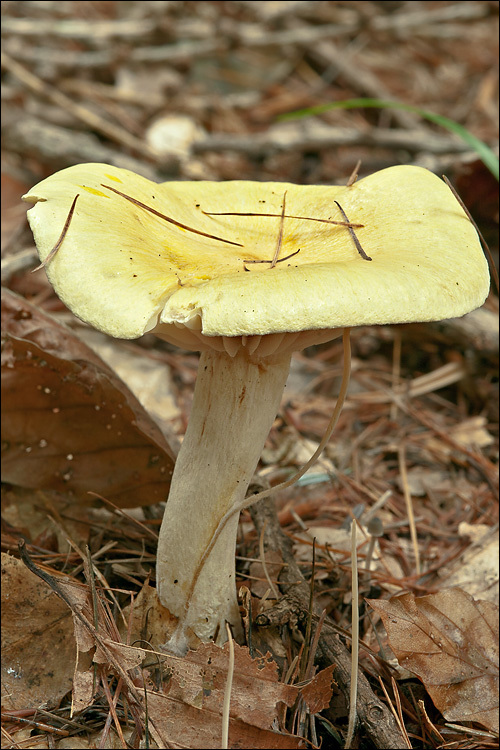
Slo.: mecesnova polevka - Habitat: Dense mixed forest of young Picea abies, Abies alba, Larix decidua and Fagus Sylvatica, under a Larix decidua, flat terrain, calcareous bedrock, probably acid soil, in full shade (almost no ground vegetation), humid place, partly protected from direct rain by tree canopies, average precipitations ~ 3.000 mm/year, average temperature 2-4 deg C, elevation 1.415 m (4.650 feet), alpine phytogeographical region. - Substratum: soil. - Comments: Growing scattered under a large Larix deciduas; about ten fruitbodies, pileus diameter up to 4 cm, fruitbodies up to 7.5 cm tall; taste and smell indistinctive; SP whitish-beige, oac899. - Spore dimensions: 9.9 (SD = 0.5) x 5.5 (SD = 0.3) micr., Q = 1.8 (SD = 0.13), n = 30. Olympus CH20 NEA 100x/1.25, magnification 1.000 x, in water, AmScope MA500. - Ref.: (1) Id'ed by Mr. Bojan Rot. (2) R.M. Daehncke, 1200 Pilze in Farbfotos, AT Verlag (2009), p 132. (3) G.J.Krieglsteiner (Hrsg.), Die Grosspilze Bade-Wrttembergs, Band 3, Ulmer (2001), p 102. (4) http://projet.aulnaies.free.fr/Florules/TRICHOLOMATALES.pdf (5) http://www.gobe.si/Gobe/HygrophorusLucorum
-

Slo.: mecesnova polevka - Habitat: Dense mixed forest of young Picea abies, Abies alba, Larix decidua and Fagus Sylvatica, under a Larix decidua, flat terrain, calcareous bedrock, probably acid soil, in full shade (almost no ground vegetation), humid place, partly protected from direct rain by tree canopies, average precipitations ~ 3.000 mm/year, average temperature 2-4 deg C, elevation 1.415 m (4.650 feet), alpine phytogeographical region. - Substratum: soil. - Comments: Growing scattered under a large Larix deciduas; about ten fruitbodies, pileus diameter up to 4 cm, fruitbodies up to 7.5 cm tall; taste and smell indistinctive; SP whitish-beige, oac899. - Spore dimensions: 9.9 (SD = 0.5) x 5.5 (SD = 0.3) micr., Q = 1.8 (SD = 0.13), n = 30. Olympus CH20 NEA 100x/1.25, magnification 1.000 x, in water, AmScope MA500. - Ref.: (1) Id'ed by Mr. Bojan Rot. (2) R.M. Daehncke, 1200 Pilze in Farbfotos, AT Verlag (2009), p 132. (3) G.J.Krieglsteiner (Hrsg.), Die Grosspilze Bade-Wrttembergs, Band 3, Ulmer (2001), p 102. (4) http://projet.aulnaies.free.fr/Florules/TRICHOLOMATALES.pdf (5) http://www.gobe.si/Gobe/HygrophorusLucorum
-
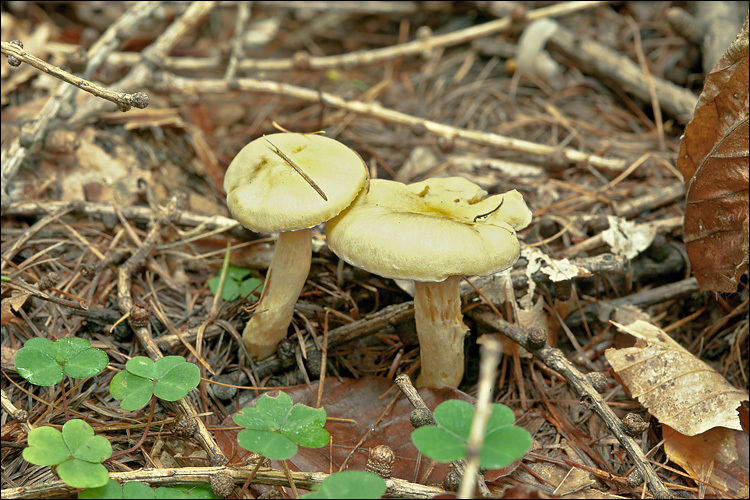
Slo.: mecesnova polevka - Habitat: Dense mixed forest of young Picea abies, Abies alba, Larix decidua and Fagus Sylvatica, under a Larix decidua, flat terrain, calcareous bedrock, probably acid soil, in full shade (almost no ground vegetation), humid place, partly protected from direct rain by tree canopies, average precipitations ~ 3.000 mm/year, average temperature 2-4 deg C, elevation 1.415 m (4.650 feet), alpine phytogeographical region. - Substratum: soil. - Comments: Growing scattered under a large Larix deciduas; about ten fruitbodies, pileus diameter up to 4 cm, fruitbodies up to 7.5 cm tall; taste and smell indistinctive; SP whitish-beige, oac899. - Spore dimensions: 9.9 (SD = 0.5) x 5.5 (SD = 0.3) micr., Q = 1.8 (SD = 0.13), n = 30. Olympus CH20 NEA 100x/1.25, magnification 1.000 x, in water, AmScope MA500. - Ref.: (1) Id'ed by Mr. Bojan Rot. (2) R.M. Daehncke, 1200 Pilze in Farbfotos, AT Verlag (2009), p 132. (3) G.J.Krieglsteiner (Hrsg.), Die Grosspilze Bade-Wrttembergs, Band 3, Ulmer (2001), p 102. (4) http://projet.aulnaies.free.fr/Florules/TRICHOLOMATALES.pdf (5) http://www.gobe.si/Gobe/HygrophorusLucorum
-
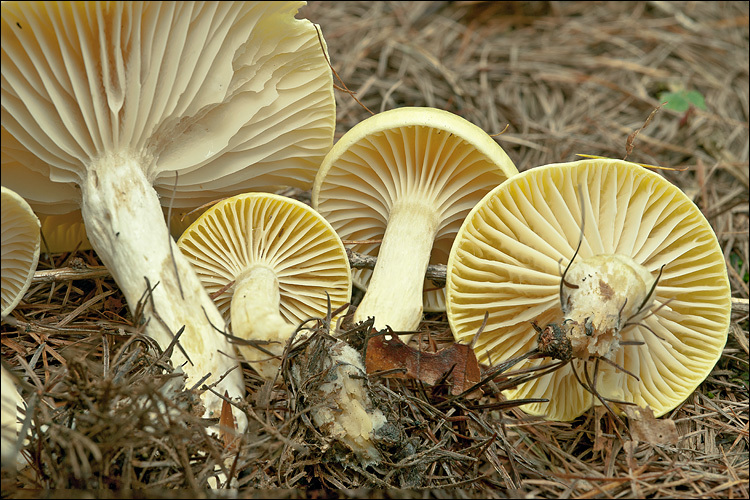
Slo.: mecesnova polevka - Habitat: Dense mixed forest of young Picea abies, Abies alba, Larix decidua and Fagus Sylvatica, under a Larix decidua, flat terrain, calcareous bedrock, probably acid soil, in full shade (almost no ground vegetation), humid place, partly protected from direct rain by tree canopies, average precipitations ~ 3.000 mm/year, average temperature 2-4 deg C, elevation 1.415 m (4.650 feet), alpine phytogeographical region. - Substratum: soil. - Comments: Growing scattered under a large Larix deciduas; about ten fruitbodies, pileus diameter up to 4 cm, fruitbodies up to 7.5 cm tall; taste and smell indistinctive; SP whitish-beige, oac899. - Spore dimensions: 9.9 (SD = 0.5) x 5.5 (SD = 0.3) micr., Q = 1.8 (SD = 0.13), n = 30. Olympus CH20 NEA 100x/1.25, magnification 1.000 x, in water, AmScope MA500. - Ref.: (1) Id'ed by Mr. Bojan Rot. (2) R.M. Daehncke, 1200 Pilze in Farbfotos, AT Verlag (2009), p 132. (3) G.J.Krieglsteiner (Hrsg.), Die Grosspilze Bade-Wrttembergs, Band 3, Ulmer (2001), p 102. (4) http://projet.aulnaies.free.fr/Florules/TRICHOLOMATALES.pdf (5) http://www.gobe.si/Gobe/HygrophorusLucorum
-
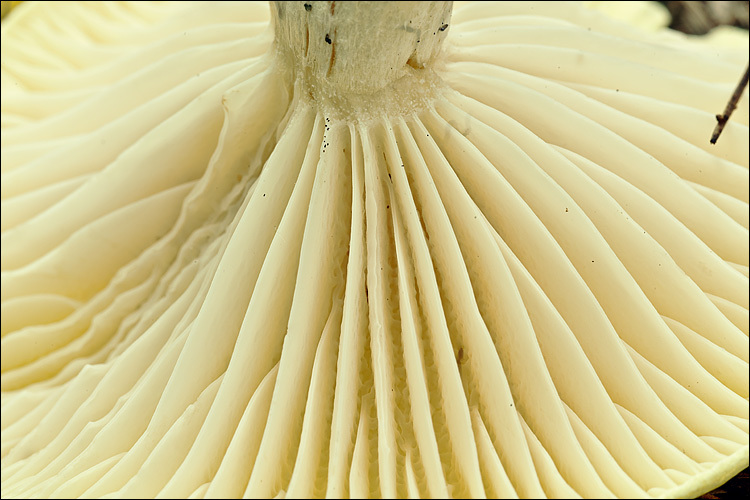
Slo.: mecesnova polevka - Habitat: Dense mixed forest of young Picea abies, Abies alba, Larix decidua and Fagus Sylvatica, under a Larix decidua, flat terrain, calcareous bedrock, probably acid soil, in full shade (almost no ground vegetation), humid place, partly protected from direct rain by tree canopies, average precipitations ~ 3.000 mm/year, average temperature 2-4 deg C, elevation 1.415 m (4.650 feet), alpine phytogeographical region. - Substratum: soil. - Comments: Growing scattered under a large Larix deciduas; about ten fruitbodies, pileus diameter up to 4 cm, fruitbodies up to 7.5 cm tall; taste and smell indistinctive; SP whitish-beige, oac899. - Spore dimensions: 9.9 (SD = 0.5) x 5.5 (SD = 0.3) micr., Q = 1.8 (SD = 0.13), n = 30. Olympus CH20 NEA 100x/1.25, magnification 1.000 x, in water, AmScope MA500. - Ref.: (1) Id'ed by Mr. Bojan Rot. (2) R.M. Daehncke, 1200 Pilze in Farbfotos, AT Verlag (2009), p 132. (3) G.J.Krieglsteiner (Hrsg.), Die Grosspilze Bade-Wrttembergs, Band 3, Ulmer (2001), p 102. (4) http://projet.aulnaies.free.fr/Florules/TRICHOLOMATALES.pdf (5) http://www.gobe.si/Gobe/HygrophorusLucorum
-

Slo.: mecesnova polevka - Habitat: Dense mixed forest of young Picea abies, Abies alba, Larix decidua and Fagus Sylvatica, under a Larix decidua, flat terrain, calcareous bedrock, probably acid soil, in full shade (almost no ground vegetation), humid place, partly protected from direct rain by tree canopies, average precipitations ~ 3.000 mm/year, average temperature 2-4 deg C, elevation 1.415 m (4.650 feet), alpine phytogeographical region. - Substratum: soil. - Comments: Growing scattered under a large Larix deciduas; about ten fruitbodies, pileus diameter up to 4 cm, fruitbodies up to 7.5 cm tall; taste and smell indistinctive; SP whitish-beige, oac899. - Spore dimensions: 9.9 (SD = 0.5) x 5.5 (SD = 0.3) micr., Q = 1.8 (SD = 0.13), n = 30. Olympus CH20 NEA 100x/1.25, magnification 1.000 x, in water, AmScope MA500. - Ref.: (1) Id'ed by Mr. Bojan Rot. (2) R.M. Daehncke, 1200 Pilze in Farbfotos, AT Verlag (2009), p 132. (3) G.J.Krieglsteiner (Hrsg.), Die Grosspilze Bade-Wrttembergs, Band 3, Ulmer (2001), p 102. (4) http://projet.aulnaies.free.fr/Florules/TRICHOLOMATALES.pdf (5) http://www.gobe.si/Gobe/HygrophorusLucorum
-
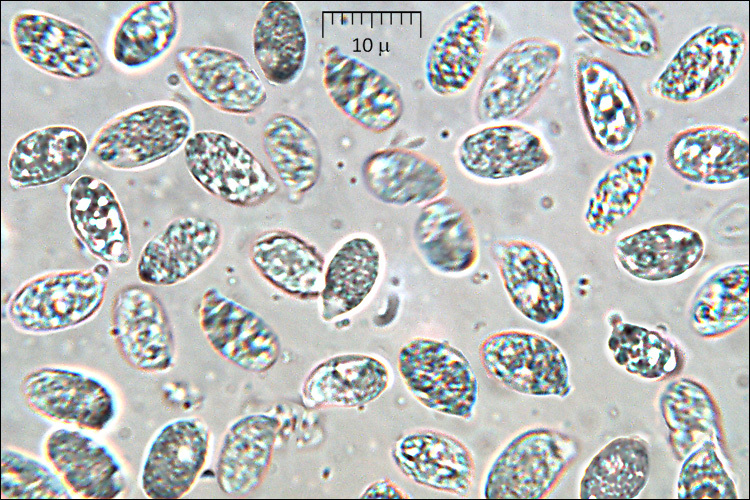
Slo.: mecesnova polevka - Habitat: Dense mixed forest of young Picea abies, Abies alba, Larix decidua and Fagus Sylvatica, under a Larix decidua, flat terrain, calcareous bedrock, probably acid soil, in full shade (almost no ground vegetation), humid place, partly protected from direct rain by tree canopies, average precipitations ~ 3.000 mm/year, average temperature 2-4 deg C, elevation 1.415 m (4.650 feet), alpine phytogeographical region. - Substratum: soil. - Comments: Growing scattered under a large Larix deciduas; about ten fruitbodies, pileus diameter up to 4 cm, fruitbodies up to 7.5 cm tall; taste and smell indistinctive; SP whitish-beige, oac899. - Spore dimensions: 9.9 (SD = 0.5) x 5.5 (SD = 0.3) micr., Q = 1.8 (SD = 0.13), n = 30. Olympus CH20 NEA 100x/1.25, magnification 1.000 x, in water, AmScope MA500. - Ref.: (1) Id'ed by Mr. Bojan Rot. (2) R.M. Daehncke, 1200 Pilze in Farbfotos, AT Verlag (2009), p 132. (3) G.J.Krieglsteiner (Hrsg.), Die Grosspilze Bade-Wrttembergs, Band 3, Ulmer (2001), p 102. (4) http://projet.aulnaies.free.fr/Florules/TRICHOLOMATALES.pdf (5) http://www.gobe.si/Gobe/HygrophorusLucorum
-

Slo.: mecesnova polevka - Habitat: Dense mixed forest of young Picea abies, Abies alba, Larix decidua and Fagus Sylvatica, under a Larix decidua, flat terrain, calcareous bedrock, probably acid soil, in full shade (almost no ground vegetation), humid place, partly protected from direct rain by tree canopies, average precipitations ~ 3.000 mm/year, average temperature 2-4 deg C, elevation 1.415 m (4.650 feet), alpine phytogeographical region. - Substratum: soil. - Comments: Growing scattered under a large Larix deciduas; about ten fruitbodies, pileus diameter up to 4 cm, fruitbodies up to 7.5 cm tall; taste and smell indistinctive; SP whitish-beige, oac899. - Spore dimensions: 9.9 (SD = 0.5) x 5.5 (SD = 0.3) micr., Q = 1.8 (SD = 0.13), n = 30. Olympus CH20 NEA 100x/1.25, magnification 1.000 x, in water, AmScope MA500. - Ref.: (1) Id'ed by Mr. Bojan Rot. (2) R.M. Daehncke, 1200 Pilze in Farbfotos, AT Verlag (2009), p 132. (3) G.J.Krieglsteiner (Hrsg.), Die Grosspilze Bade-Wrttembergs, Band 3, Ulmer (2001), p 102. (4) http://projet.aulnaies.free.fr/Florules/TRICHOLOMATALES.pdf (5) http://www.gobe.si/Gobe/HygrophorusLucorum
-
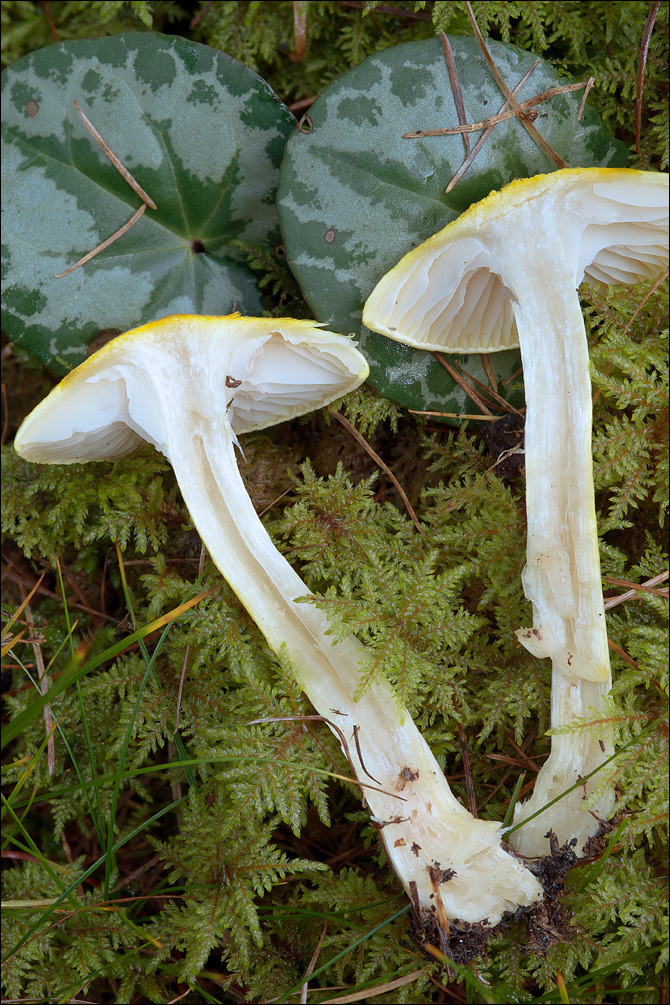
Slo.: mecesnova polevka - Habitat: steep grassland, extensively used; south aspect; calcareous ground; under a group of three large Larix decidua trees; dry, sunny place (but in shade of a mountain during winter months); partly protected from direct rain by tree canopies; average precipitations ~ 3.000 mm/year, average temperature 5 -7 deg C, elevation 850 m (2.800 feet), alpine phytogeographical region. Substratum: soil under Larix decidua. Place: Zadnjica valley, right bank of Krajcerca stream bed, at the foot of Mt. Pihavec, near the uppermost cottage in the valley, East Julian Alps, Posoje, Slovenia EC. Comments: Hygrophorus lucorum is not a common species but it is easy to recognize. It is unequivocally characterized by its habitat under Larix decidua on calcareous ground and its vivid lemon yellow to gold-yellow color of pilei, which cannot be overlooked in green grassland. Growing solitary and in small groups, over twenty pilei found; pilei diameter 1.8 - 4.5 cm, up to 1.5 cm high; stipe from 3.8 to 4.5 cm tall and of 8 to 9 mm in diameter; taste mild mushroomy; smell mild, pleasant, mushroomy; SP whitish with a yellow tint, oac14. Spores smooth. Dimensions: 7.9 [9.3 ; 9.8] 11.2 x 4.4 [5.1 ; 5.4] 6.2 microns; Q = 1.5 [1.8 ; 1.9] 2.2; N = 40; C = 95%; Me = 9.6 x 5.3 microns; Qe = 1.8. Olympus CH20, NEA 100x/1.25, magnification 1.000 x, oil, in water, in vivo. AmScope MA500 digital camera. Herbarium: Mycotheca and lichen herbarium (LJU-Li) of Slovenian Forestry Institute, Vena pot 2, Ljubljana, Index Herbariorum LJF Ref.: (1) R.M. Daehncke, 1200 Pilze in Farbfotos, AT Verlag (2009), p 132. (2) G.J.Krieglsteiner (Hrsg.), Die Grosspilze Bade-Wrttembergs, Band 3, Ulmer (2001), p 102. (3) S. Buczacki, Collins Fungi Guide, Collins (2012), p 262. (4) J. Breitenbach, F. Kraenzlin, Eds., Fungi of Switzerland, Vol.3. Verlag Mykologia (1991), p 128. (5) R. Lueder, Grundkurs Pilzbestimmung, Quelle & Meyer (2008), p 246.
-
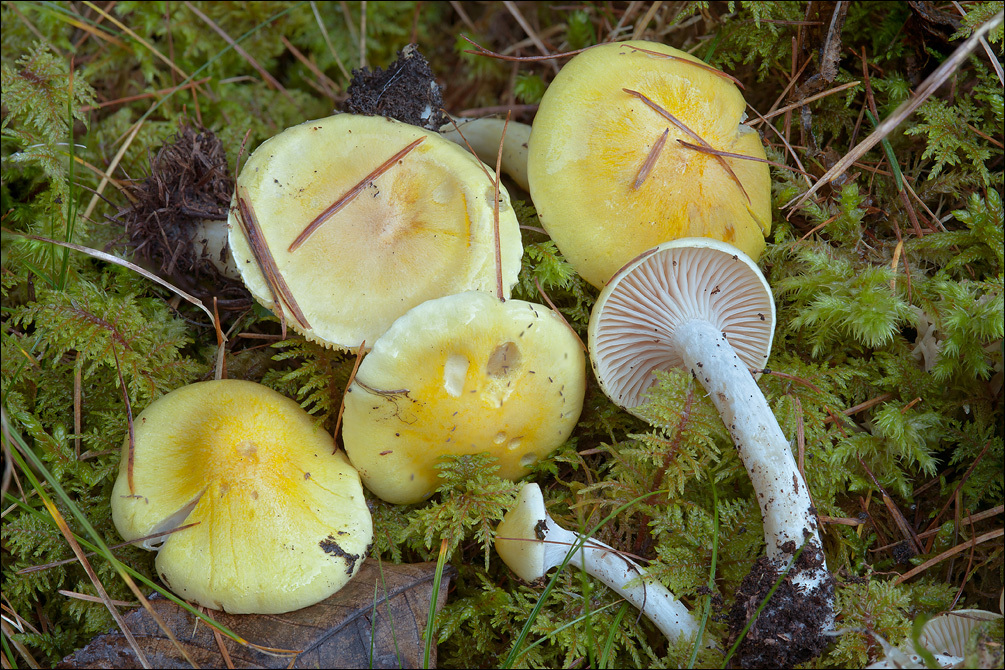
Slo.: mecesnova polevka - Habitat: steep grassland, extensively used; south aspect; calcareous ground; under a group of three large Larix decidua trees; dry, sunny place (but in shade of a mountain during winter months); partly protected from direct rain by tree canopies; average precipitations ~ 3.000 mm/year, average temperature 5 -7 deg C, elevation 850 m (2.800 feet), alpine phytogeographical region. Substratum: soil under Larix decidua. Place: Zadnjica valley, right bank of Krajcerca stream bed, at the foot of Mt. Pihavec, near the uppermost cottage in the valley, East Julian Alps, Posoje, Slovenia EC. Comments: Hygrophorus lucorum is not a common species but it is easy to recognize. It is unequivocally characterized by its habitat under Larix decidua on calcareous ground and its vivid lemon yellow to gold-yellow color of pilei, which cannot be overlooked in green grassland. Growing solitary and in small groups, over twenty pilei found; pilei diameter 1.8 - 4.5 cm, up to 1.5 cm high; stipe from 3.8 to 4.5 cm tall and of 8 to 9 mm in diameter; taste mild mushroomy; smell mild, pleasant, mushroomy; SP whitish with a yellow tint, oac14. Spores smooth. Dimensions: 7.9 [9.3 ; 9.8] 11.2 x 4.4 [5.1 ; 5.4] 6.2 microns; Q = 1.5 [1.8 ; 1.9] 2.2; N = 40; C = 95%; Me = 9.6 x 5.3 microns; Qe = 1.8. Olympus CH20, NEA 100x/1.25, magnification 1.000 x, oil, in water, in vivo. AmScope MA500 digital camera. Herbarium: Mycotheca and lichen herbarium (LJU-Li) of Slovenian Forestry Institute, Vena pot 2, Ljubljana, Index Herbariorum LJF Ref.: (1) R.M. Daehncke, 1200 Pilze in Farbfotos, AT Verlag (2009), p 132. (2) G.J.Krieglsteiner (Hrsg.), Die Grosspilze Bade-Wrttembergs, Band 3, Ulmer (2001), p 102. (3) S. Buczacki, Collins Fungi Guide, Collins (2012), p 262. (4) J. Breitenbach, F. Kraenzlin, Eds., Fungi of Switzerland, Vol.3. Verlag Mykologia (1991), p 128. (5) R. Lueder, Grundkurs Pilzbestimmung, Quelle & Meyer (2008), p 246.
-
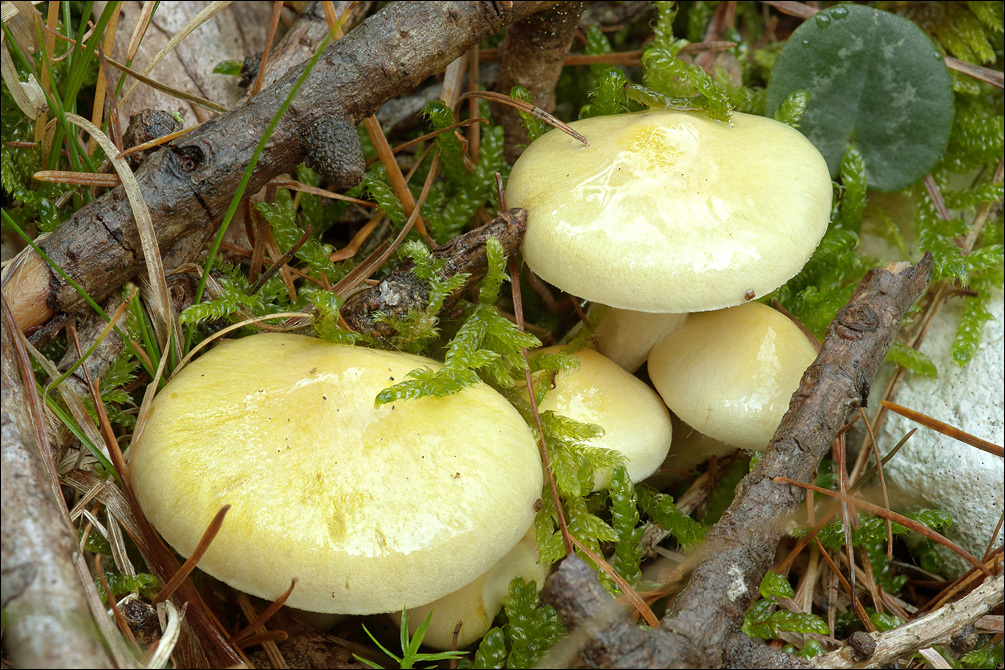
Slo.: mecesnova polevka - Habitat: steep grassland, extensively used; south aspect; calcareous ground; under a group of three large Larix decidua trees; dry, sunny place (but in shade of a mountain during winter months); partly protected from direct rain by tree canopies; average precipitations ~ 3.000 mm/year, average temperature 5 -7 deg C, elevation 850 m (2.800 feet), alpine phytogeographical region. Substratum: soil under Larix decidua. Place: Zadnjica valley, right bank of Krajcerca stream bed, at the foot of Mt. Pihavec, near the uppermost cottage in the valley, East Julian Alps, Posoje, Slovenia EC. Comments: Hygrophorus lucorum is not a common species but it is easy to recognize. It is unequivocally characterized by its habitat under Larix decidua on calcareous ground and its vivid lemon yellow to gold-yellow color of pilei, which cannot be overlooked in green grassland. Growing solitary and in small groups, over twenty pilei found; pilei diameter 1.8 - 4.5 cm, up to 1.5 cm high; stipe from 3.8 to 4.5 cm tall and of 8 to 9 mm in diameter; taste mild mushroomy; smell mild, pleasant, mushroomy; SP whitish with a yellow tint, oac14. Spores smooth. Dimensions: 7.9 [9.3 ; 9.8] 11.2 x 4.4 [5.1 ; 5.4] 6.2 microns; Q = 1.5 [1.8 ; 1.9] 2.2; N = 40; C = 95%; Me = 9.6 x 5.3 microns; Qe = 1.8. Olympus CH20, NEA 100x/1.25, magnification 1.000 x, oil, in water, in vivo. AmScope MA500 digital camera. Herbarium: Mycotheca and lichen herbarium (LJU-Li) of Slovenian Forestry Institute, Vena pot 2, Ljubljana, Index Herbariorum LJF Ref.: (1) R.M. Daehncke, 1200 Pilze in Farbfotos, AT Verlag (2009), p 132. (2) G.J.Krieglsteiner (Hrsg.), Die Grosspilze Bade-Wrttembergs, Band 3, Ulmer (2001), p 102. (3) S. Buczacki, Collins Fungi Guide, Collins (2012), p 262. (4) J. Breitenbach, F. Kraenzlin, Eds., Fungi of Switzerland, Vol.3. Verlag Mykologia (1991), p 128. (5) R. Lueder, Grundkurs Pilzbestimmung, Quelle & Meyer (2008), p 246.
-
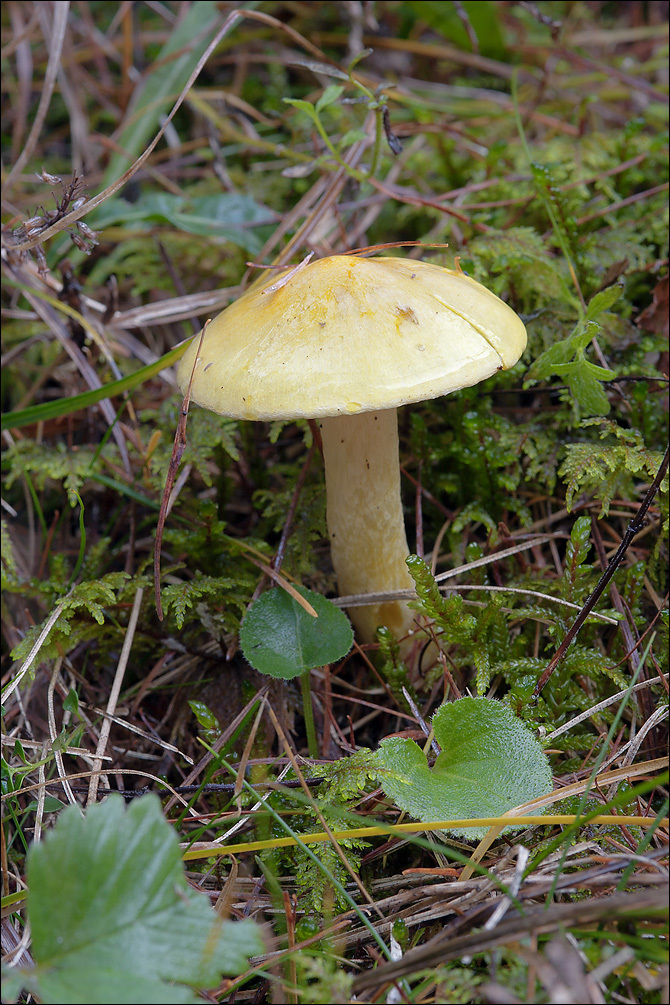
Slo.: mecesnova polevka - Habitat: steep grassland, extensively used; south aspect; calcareous ground; under a group of three large Larix decidua trees; dry, sunny place (but in shade of a mountain during winter months); partly protected from direct rain by tree canopies; average precipitations ~ 3.000 mm/year, average temperature 5 -7 deg C, elevation 850 m (2.800 feet), alpine phytogeographical region. Substratum: soil under Larix decidua. Place: Zadnjica valley, right bank of Krajcerca stream bed, at the foot of Mt. Pihavec, near the uppermost cottage in the valley, East Julian Alps, Posoje, Slovenia EC. Comments: Hygrophorus lucorum is not a common species but it is easy to recognize. It is unequivocally characterized by its habitat under Larix decidua on calcareous ground and its vivid lemon yellow to gold-yellow color of pilei, which cannot be overlooked in green grassland. Growing solitary and in small groups, over twenty pilei found; pilei diameter 1.8 - 4.5 cm, up to 1.5 cm high; stipe from 3.8 to 4.5 cm tall and of 8 to 9 mm in diameter; taste mild mushroomy; smell mild, pleasant, mushroomy; SP whitish with a yellow tint, oac14. Spores smooth. Dimensions: 7.9 [9.3 ; 9.8] 11.2 x 4.4 [5.1 ; 5.4] 6.2 microns; Q = 1.5 [1.8 ; 1.9] 2.2; N = 40; C = 95%; Me = 9.6 x 5.3 microns; Qe = 1.8. Olympus CH20, NEA 100x/1.25, magnification 1.000 x, oil, in water, in vivo. AmScope MA500 digital camera. Herbarium: Mycotheca and lichen herbarium (LJU-Li) of Slovenian Forestry Institute, Vena pot 2, Ljubljana, Index Herbariorum LJF Ref.: (1) R.M. Daehncke, 1200 Pilze in Farbfotos, AT Verlag (2009), p 132. (2) G.J.Krieglsteiner (Hrsg.), Die Grosspilze Bade-Wrttembergs, Band 3, Ulmer (2001), p 102. (3) S. Buczacki, Collins Fungi Guide, Collins (2012), p 262. (4) J. Breitenbach, F. Kraenzlin, Eds., Fungi of Switzerland, Vol.3. Verlag Mykologia (1991), p 128. (5) R. Lueder, Grundkurs Pilzbestimmung, Quelle & Meyer (2008), p 246.
-
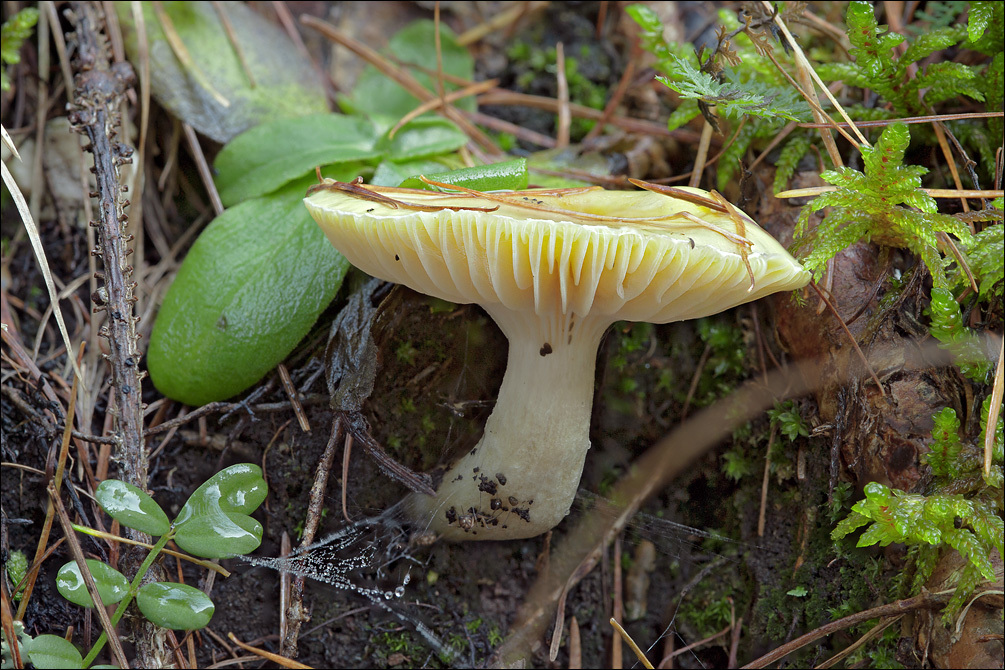
Slo.: mecesnova polevka - Habitat: steep grassland, extensively used; south aspect; calcareous ground; under a group of three large Larix decidua trees; dry, sunny place (but in shade of a mountain during winter months); partly protected from direct rain by tree canopies; average precipitations ~ 3.000 mm/year, average temperature 5 -7 deg C, elevation 850 m (2.800 feet), alpine phytogeographical region. Substratum: soil under Larix decidua. Place: Zadnjica valley, right bank of Krajcerca stream bed, at the foot of Mt. Pihavec, near the uppermost cottage in the valley, East Julian Alps, Posoje, Slovenia EC. Comments: Hygrophorus lucorum is not a common species but it is easy to recognize. It is unequivocally characterized by its habitat under Larix decidua on calcareous ground and its vivid lemon yellow to gold-yellow color of pilei, which cannot be overlooked in green grassland. Growing solitary and in small groups, over twenty pilei found; pilei diameter 1.8 - 4.5 cm, up to 1.5 cm high; stipe from 3.8 to 4.5 cm tall and of 8 to 9 mm in diameter; taste mild mushroomy; smell mild, pleasant, mushroomy; SP whitish with a yellow tint, oac14. Spores smooth. Dimensions: 7.9 [9.3 ; 9.8] 11.2 x 4.4 [5.1 ; 5.4] 6.2 microns; Q = 1.5 [1.8 ; 1.9] 2.2; N = 40; C = 95%; Me = 9.6 x 5.3 microns; Qe = 1.8. Olympus CH20, NEA 100x/1.25, magnification 1.000 x, oil, in water, in vivo. AmScope MA500 digital camera. Herbarium: Mycotheca and lichen herbarium (LJU-Li) of Slovenian Forestry Institute, Vena pot 2, Ljubljana, Index Herbariorum LJF Ref.: (1) R.M. Daehncke, 1200 Pilze in Farbfotos, AT Verlag (2009), p 132. (2) G.J.Krieglsteiner (Hrsg.), Die Grosspilze Bade-Wrttembergs, Band 3, Ulmer (2001), p 102. (3) S. Buczacki, Collins Fungi Guide, Collins (2012), p 262. (4) J. Breitenbach, F. Kraenzlin, Eds., Fungi of Switzerland, Vol.3. Verlag Mykologia (1991), p 128. (5) R. Lueder, Grundkurs Pilzbestimmung, Quelle & Meyer (2008), p 246.
-
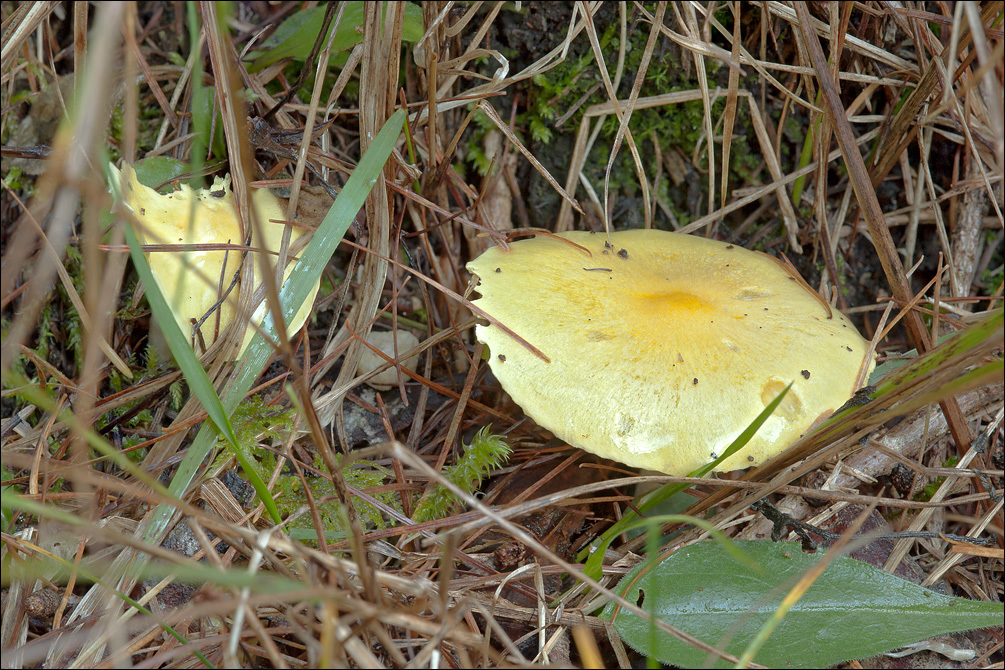
Slo.: mecesnova polevka - Habitat: steep grassland, extensively used; south aspect; calcareous ground; under a group of three large Larix decidua trees; dry, sunny place (but in shade of a mountain during winter months); partly protected from direct rain by tree canopies; average precipitations ~ 3.000 mm/year, average temperature 5 -7 deg C, elevation 850 m (2.800 feet), alpine phytogeographical region. Substratum: soil under Larix decidua. Place: Zadnjica valley, right bank of Krajcerca stream bed, at the foot of Mt. Pihavec, near the uppermost cottage in the valley, East Julian Alps, Posoje, Slovenia EC. Comments: Hygrophorus lucorum is not a common species but it is easy to recognize. It is unequivocally characterized by its habitat under Larix decidua on calcareous ground and its vivid lemon yellow to gold-yellow color of pilei, which cannot be overlooked in green grassland. Growing solitary and in small groups, over twenty pilei found; pilei diameter 1.8 - 4.5 cm, up to 1.5 cm high; stipe from 3.8 to 4.5 cm tall and of 8 to 9 mm in diameter; taste mild mushroomy; smell mild, pleasant, mushroomy; SP whitish with a yellow tint, oac14. Spores smooth. Dimensions: 7.9 [9.3 ; 9.8] 11.2 x 4.4 [5.1 ; 5.4] 6.2 microns; Q = 1.5 [1.8 ; 1.9] 2.2; N = 40; C = 95%; Me = 9.6 x 5.3 microns; Qe = 1.8. Olympus CH20, NEA 100x/1.25, magnification 1.000 x, oil, in water, in vivo. AmScope MA500 digital camera. Herbarium: Mycotheca and lichen herbarium (LJU-Li) of Slovenian Forestry Institute, Vena pot 2, Ljubljana, Index Herbariorum LJF Ref.: (1) R.M. Daehncke, 1200 Pilze in Farbfotos, AT Verlag (2009), p 132. (2) G.J.Krieglsteiner (Hrsg.), Die Grosspilze Bade-Wrttembergs, Band 3, Ulmer (2001), p 102. (3) S. Buczacki, Collins Fungi Guide, Collins (2012), p 262. (4) J. Breitenbach, F. Kraenzlin, Eds., Fungi of Switzerland, Vol.3. Verlag Mykologia (1991), p 128. (5) R. Lueder, Grundkurs Pilzbestimmung, Quelle & Meyer (2008), p 246.
-

Slo.: mecesnova polevka - Habitat: steep grassland, extensively used; south aspect; calcareous ground; under a group of three large Larix decidua trees; dry, sunny place (but in shade of a mountain during winter months); partly protected from direct rain by tree canopies; average precipitations ~ 3.000 mm/year, average temperature 5 -7 deg C, elevation 850 m (2.800 feet), alpine phytogeographical region. Substratum: soil under Larix decidua. Place: Zadnjica valley, right bank of Krajcerca stream bed, at the foot of Mt. Pihavec, near the uppermost cottage in the valley, East Julian Alps, Posoje, Slovenia EC. Comments: Hygrophorus lucorum is not a common species but it is easy to recognize. It is unequivocally characterized by its habitat under Larix decidua on calcareous ground and its vivid lemon yellow to gold-yellow color of pilei, which cannot be overlooked in green grassland. Growing solitary and in small groups, over twenty pilei found; pilei diameter 1.8 - 4.5 cm, up to 1.5 cm high; stipe from 3.8 to 4.5 cm tall and of 8 to 9 mm in diameter; taste mild mushroomy; smell mild, pleasant, mushroomy; SP whitish with a yellow tint, oac14. Spores smooth. Dimensions: 7.9 [9.3 ; 9.8] 11.2 x 4.4 [5.1 ; 5.4] 6.2 microns; Q = 1.5 [1.8 ; 1.9] 2.2; N = 40; C = 95%; Me = 9.6 x 5.3 microns; Qe = 1.8. Olympus CH20, NEA 100x/1.25, magnification 1.000 x, oil, in water, in vivo. AmScope MA500 digital camera. Herbarium: Mycotheca and lichen herbarium (LJU-Li) of Slovenian Forestry Institute, Vena pot 2, Ljubljana, Index Herbariorum LJF Ref.: (1) R.M. Daehncke, 1200 Pilze in Farbfotos, AT Verlag (2009), p 132. (2) G.J.Krieglsteiner (Hrsg.), Die Grosspilze Bade-Wrttembergs, Band 3, Ulmer (2001), p 102. (3) S. Buczacki, Collins Fungi Guide, Collins (2012), p 262. (4) J. Breitenbach, F. Kraenzlin, Eds., Fungi of Switzerland, Vol.3. Verlag Mykologia (1991), p 128. (5) R. Lueder, Grundkurs Pilzbestimmung, Quelle & Meyer (2008), p 246.
-
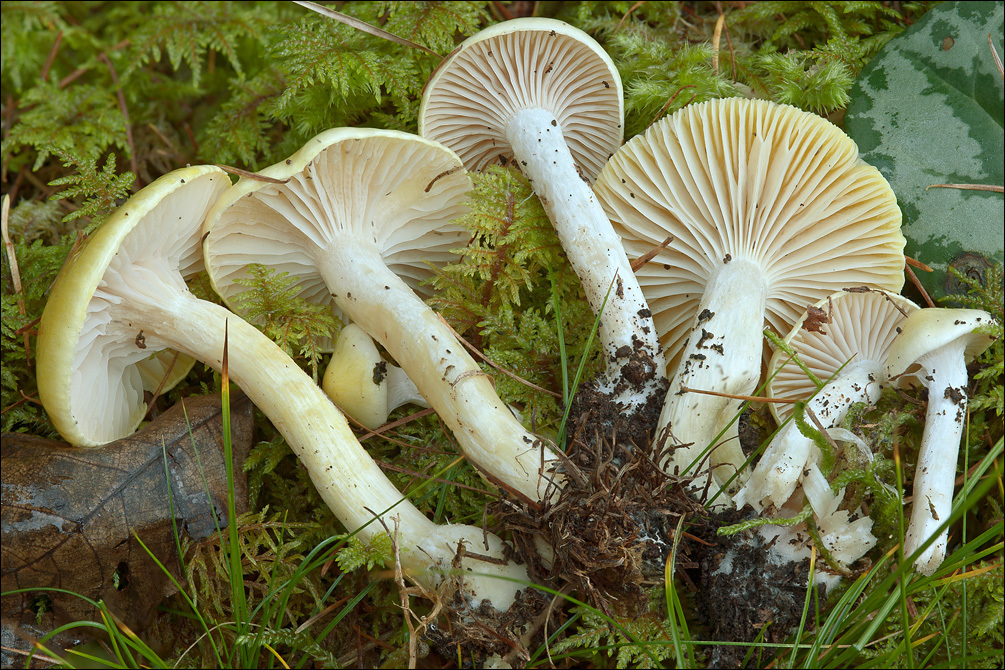
Slo.: mecesnova polevka - Habitat: steep grassland, extensively used; south aspect; calcareous ground; under a group of three large Larix decidua trees; dry, sunny place (but in shade of a mountain during winter months); partly protected from direct rain by tree canopies; average precipitations ~ 3.000 mm/year, average temperature 5 -7 deg C, elevation 850 m (2.800 feet), alpine phytogeographical region. Substratum: soil under Larix decidua. Place: Zadnjica valley, right bank of Krajcerca stream bed, at the foot of Mt. Pihavec, near the uppermost cottage in the valley, East Julian Alps, Posoje, Slovenia EC. Comments: Hygrophorus lucorum is not a common species but it is easy to recognize. It is unequivocally characterized by its habitat under Larix decidua on calcareous ground and its vivid lemon yellow to gold-yellow color of pilei, which cannot be overlooked in green grassland. Growing solitary and in small groups, over twenty pilei found; pilei diameter 1.8 - 4.5 cm, up to 1.5 cm high; stipe from 3.8 to 4.5 cm tall and of 8 to 9 mm in diameter; taste mild mushroomy; smell mild, pleasant, mushroomy; SP whitish with a yellow tint, oac14. Spores smooth. Dimensions: 7.9 [9.3 ; 9.8] 11.2 x 4.4 [5.1 ; 5.4] 6.2 microns; Q = 1.5 [1.8 ; 1.9] 2.2; N = 40; C = 95%; Me = 9.6 x 5.3 microns; Qe = 1.8. Olympus CH20, NEA 100x/1.25, magnification 1.000 x, oil, in water, in vivo. AmScope MA500 digital camera. Herbarium: Mycotheca and lichen herbarium (LJU-Li) of Slovenian Forestry Institute, Vena pot 2, Ljubljana, Index Herbariorum LJF Ref.: (1) R.M. Daehncke, 1200 Pilze in Farbfotos, AT Verlag (2009), p 132. (2) G.J.Krieglsteiner (Hrsg.), Die Grosspilze Bade-Wrttembergs, Band 3, Ulmer (2001), p 102. (3) S. Buczacki, Collins Fungi Guide, Collins (2012), p 262. (4) J. Breitenbach, F. Kraenzlin, Eds., Fungi of Switzerland, Vol.3. Verlag Mykologia (1991), p 128. (5) R. Lueder, Grundkurs Pilzbestimmung, Quelle & Meyer (2008), p 246.
-

Slo.: mecesnova polevka - Habitat: steep grassland, extensively used; south aspect; calcareous ground; under a group of three large Larix decidua trees; dry, sunny place (but in shade of a mountain during winter months); partly protected from direct rain by tree canopies; average precipitations ~ 3.000 mm/year, average temperature 5 -7 deg C, elevation 850 m (2.800 feet), alpine phytogeographical region. Substratum: soil under Larix decidua. Place: Zadnjica valley, right bank of Krajcerca stream bed, at the foot of Mt. Pihavec, near the uppermost cottage in the valley, East Julian Alps, Posoje, Slovenia EC. Comments: Hygrophorus lucorum is not a common species but it is easy to recognize. It is unequivocally characterized by its habitat under Larix decidua on calcareous ground and its vivid lemon yellow to gold-yellow color of pilei, which cannot be overlooked in green grassland. Growing solitary and in small groups, over twenty pilei found; pilei diameter 1.8 - 4.5 cm, up to 1.5 cm high; stipe from 3.8 to 4.5 cm tall and of 8 to 9 mm in diameter; taste mild mushroomy; smell mild, pleasant, mushroomy; SP whitish with a yellow tint, oac14. Spores smooth. Dimensions: 7.9 [9.3 ; 9.8] 11.2 x 4.4 [5.1 ; 5.4] 6.2 microns; Q = 1.5 [1.8 ; 1.9] 2.2; N = 40; C = 95%; Me = 9.6 x 5.3 microns; Qe = 1.8. Olympus CH20, NEA 100x/1.25, magnification 1.000 x, oil, in water, in vivo. AmScope MA500 digital camera. Herbarium: Mycotheca and lichen herbarium (LJU-Li) of Slovenian Forestry Institute, Vena pot 2, Ljubljana, Index Herbariorum LJF Ref.: (1) R.M. Daehncke, 1200 Pilze in Farbfotos, AT Verlag (2009), p 132. (2) G.J.Krieglsteiner (Hrsg.), Die Grosspilze Bade-Wrttembergs, Band 3, Ulmer (2001), p 102. (3) S. Buczacki, Collins Fungi Guide, Collins (2012), p 262. (4) J. Breitenbach, F. Kraenzlin, Eds., Fungi of Switzerland, Vol.3. Verlag Mykologia (1991), p 128. (5) R. Lueder, Grundkurs Pilzbestimmung, Quelle & Meyer (2008), p 246.
-

Slo.: mecesnova polevka - Habitat: steep grassland, extensively used; south aspect; calcareous ground; under a group of three large Larix decidua trees; dry, sunny place (but in shade of a mountain during winter months); partly protected from direct rain by tree canopies; average precipitations ~ 3.000 mm/year, average temperature 5 -7 deg C, elevation 850 m (2.800 feet), alpine phytogeographical region. Substratum: soil under Larix decidua. Place: Zadnjica valley, right bank of Krajcerca stream bed, at the foot of Mt. Pihavec, near the uppermost cottage in the valley, East Julian Alps, Posoje, Slovenia EC. Comments: Hygrophorus lucorum is not a common species but it is easy to recognize. It is unequivocally characterized by its habitat under Larix decidua on calcareous ground and its vivid lemon yellow to gold-yellow color of pilei, which cannot be overlooked in green grassland. Growing solitary and in small groups, over twenty pilei found; pilei diameter 1.8 - 4.5 cm, up to 1.5 cm high; stipe from 3.8 to 4.5 cm tall and of 8 to 9 mm in diameter; taste mild mushroomy; smell mild, pleasant, mushroomy; SP whitish with a yellow tint, oac14. Spores smooth. Dimensions: 7.9 [9.3 ; 9.8] 11.2 x 4.4 [5.1 ; 5.4] 6.2 microns; Q = 1.5 [1.8 ; 1.9] 2.2; N = 40; C = 95%; Me = 9.6 x 5.3 microns; Qe = 1.8. Olympus CH20, NEA 100x/1.25, magnification 1.000 x, oil, in water, in vivo. AmScope MA500 digital camera. Herbarium: Mycotheca and lichen herbarium (LJU-Li) of Slovenian Forestry Institute, Vena pot 2, Ljubljana, Index Herbariorum LJF Ref.: (1) R.M. Daehncke, 1200 Pilze in Farbfotos, AT Verlag (2009), p 132. (2) G.J.Krieglsteiner (Hrsg.), Die Grosspilze Bade-Wrttembergs, Band 3, Ulmer (2001), p 102. (3) S. Buczacki, Collins Fungi Guide, Collins (2012), p 262. (4) J. Breitenbach, F. Kraenzlin, Eds., Fungi of Switzerland, Vol.3. Verlag Mykologia (1991), p 128. (5) R. Lueder, Grundkurs Pilzbestimmung, Quelle & Meyer (2008), p 246.
-
Mushroom Observer Image 584893: Hygrophorus lucorum Kalchbr.
-
Mushroom Observer Image 584894: Hygrophorus lucorum Kalchbr.
-
-
-
-

